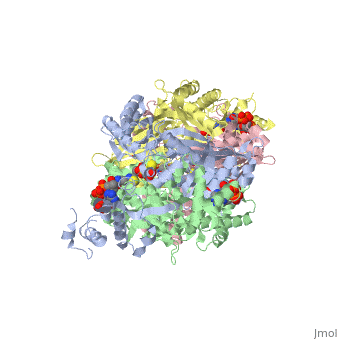1dq8: Difference between revisions
No edit summary |
No edit summary |
||
| Line 1: | Line 1: | ||
==COMPLEX OF THE CATALYTIC PORTION OF HUMAN HMG-COA REDUCTASE WITH HMG AND COA== | ==COMPLEX OF THE CATALYTIC PORTION OF HUMAN HMG-COA REDUCTASE WITH HMG AND COA== | ||
<StructureSection load='1dq8' size='340' side='right' caption='[[1dq8]], [[Resolution|resolution]] 2.10Å' scene=''> | <StructureSection load='1dq8' size='340' side='right'caption='[[1dq8]], [[Resolution|resolution]] 2.10Å' scene=''> | ||
== Structural highlights == | == Structural highlights == | ||
<table><tr><td colspan='2'>[[1dq8]] is a 4 chain structure with sequence from [ | <table><tr><td colspan='2'>[[1dq8]] is a 4 chain structure with sequence from [https://en.wikipedia.org/wiki/Human Human]. Full crystallographic information is available from [http://oca.weizmann.ac.il/oca-bin/ocashort?id=1DQ8 OCA]. For a <b>guided tour on the structure components</b> use [https://proteopedia.org/fgij/fg.htm?mol=1DQ8 FirstGlance]. <br> | ||
</td></tr><tr id='ligand'><td class="sblockLbl"><b>[[Ligand|Ligands:]]</b></td><td class="sblockDat"><scene name='pdbligand=COA:COENZYME+A'>COA</scene>, <scene name='pdbligand=DTT:2,3-DIHYDROXY-1,4-DITHIOBUTANE'>DTT</scene>, <scene name='pdbligand=MAH:3-HYDROXY-3-METHYL-GLUTARIC+ACID'>MAH</scene></td></tr> | </td></tr><tr id='ligand'><td class="sblockLbl"><b>[[Ligand|Ligands:]]</b></td><td class="sblockDat" id="ligandDat"><scene name='pdbligand=COA:COENZYME+A'>COA</scene>, <scene name='pdbligand=DTT:2,3-DIHYDROXY-1,4-DITHIOBUTANE'>DTT</scene>, <scene name='pdbligand=MAH:3-HYDROXY-3-METHYL-GLUTARIC+ACID'>MAH</scene></td></tr> | ||
<tr id='activity'><td class="sblockLbl"><b>Activity:</b></td><td class="sblockDat"><span class='plainlinks'>[ | <tr id='activity'><td class="sblockLbl"><b>Activity:</b></td><td class="sblockDat"><span class='plainlinks'>[https://en.wikipedia.org/wiki/Hydroxymethylglutaryl-CoA_reductase_(NADPH) Hydroxymethylglutaryl-CoA reductase (NADPH)], with EC number [https://www.brenda-enzymes.info/php/result_flat.php4?ecno=1.1.1.34 1.1.1.34] </span></td></tr> | ||
<tr id='resources'><td class="sblockLbl"><b>Resources:</b></td><td class="sblockDat"><span class='plainlinks'>[ | <tr id='resources'><td class="sblockLbl"><b>Resources:</b></td><td class="sblockDat"><span class='plainlinks'>[https://proteopedia.org/fgij/fg.htm?mol=1dq8 FirstGlance], [http://oca.weizmann.ac.il/oca-bin/ocaids?id=1dq8 OCA], [https://pdbe.org/1dq8 PDBe], [https://www.rcsb.org/pdb/explore.do?structureId=1dq8 RCSB], [https://www.ebi.ac.uk/pdbsum/1dq8 PDBsum], [https://prosat.h-its.org/prosat/prosatexe?pdbcode=1dq8 ProSAT]</span></td></tr> | ||
</table> | </table> | ||
== Function == | == Function == | ||
[[ | [[https://www.uniprot.org/uniprot/HMDH_HUMAN HMDH_HUMAN]] Transmembrane glycoprotein that is the rate-limiting enzyme in cholesterol biosynthesis as well as in the biosynthesis of nonsterol isoprenoids that are essential for normal cell function including ubiquinone and geranylgeranyl proteins. | ||
== Evolutionary Conservation == | == Evolutionary Conservation == | ||
[[Image:Consurf_key_small.gif|200px|right]] | [[Image:Consurf_key_small.gif|200px|right]] | ||
| Line 31: | Line 31: | ||
==See Also== | ==See Also== | ||
*[[HMG-CoA Reductase|HMG-CoA Reductase]] | *[[HMG-CoA Reductase|HMG-CoA Reductase]] | ||
*[[ | *[[HMG-CoA Reductase 3D structures|HMG-CoA Reductase 3D structures]] | ||
== References == | == References == | ||
<references/> | <references/> | ||
| Line 43: | Line 38: | ||
</StructureSection> | </StructureSection> | ||
[[Category: Human]] | [[Category: Human]] | ||
[[Category: Large Structures]] | |||
[[Category: Buchanan, S K]] | [[Category: Buchanan, S K]] | ||
[[Category: Deisenhofer, J]] | [[Category: Deisenhofer, J]] | ||
Revision as of 23:29, 20 October 2021
COMPLEX OF THE CATALYTIC PORTION OF HUMAN HMG-COA REDUCTASE WITH HMG AND COACOMPLEX OF THE CATALYTIC PORTION OF HUMAN HMG-COA REDUCTASE WITH HMG AND COA
Structural highlights
Function[HMDH_HUMAN] Transmembrane glycoprotein that is the rate-limiting enzyme in cholesterol biosynthesis as well as in the biosynthesis of nonsterol isoprenoids that are essential for normal cell function including ubiquinone and geranylgeranyl proteins. Evolutionary Conservation Check, as determined by ConSurfDB. You may read the explanation of the method and the full data available from ConSurf. Publication Abstract from PubMed3-hydroxy-3-methylglutaryl-CoA reductase (HMGR) catalyzes the formation of mevalonate, the committed step in the biosynthesis of sterols and isoprenoids. The activity of HMGR is controlled through synthesis, degradation and phosphorylation to maintain the concentration of mevalonate-derived products. In addition to the physiological regulation of HMGR, the human enzyme has been targeted successfully by drugs in the clinical treatment of high serum cholesterol levels. Three crystal structures of the catalytic portion of human HMGR in complexes with HMG-CoA, with HMG and CoA, and with HMG, CoA and NADP(+), provide a detailed view of the enzyme active site. Catalytic portions of human HMGR form tight tetramers. The crystal structure explains the influence of the enzyme's oligomeric state on the activity and suggests a mechanism for cholesterol sensing. The active site architecture of human HMGR is different from that of bacterial HMGR; this may explain why binding of HMGR inhibitors to bacterial HMGRs has not been reported. Crystal structure of the catalytic portion of human HMG-CoA reductase: insights into regulation of activity and catalysis.,Istvan ES, Palnitkar M, Buchanan SK, Deisenhofer J EMBO J. 2000 Mar 1;19(5):819-30. PMID:10698924[1] From MEDLINE®/PubMed®, a database of the U.S. National Library of Medicine. See AlsoReferences
|
| ||||||||||||||||||
